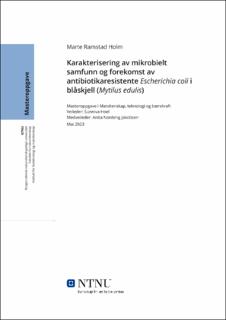| dc.contributor.advisor | Hoel, Sunniva | |
| dc.contributor.advisor | Jakobsen, Anita Nordeng | |
| dc.contributor.author | Holm, Marte Ramstad | |
| dc.date.accessioned | 2023-06-27T17:19:44Z | |
| dc.date.available | 2023-06-27T17:19:44Z | |
| dc.date.issued | 2023 | |
| dc.identifier | no.ntnu:inspera:143476308:44848494 | |
| dc.identifier.uri | https://hdl.handle.net/11250/3073731 | |
| dc.description.abstract | Filterfôringsmekanismen til blåskjell fører til at partikler i miljøet rundt filtreres og oppkonsentreres, og dermed blir blåskjell ansett til å gjenspeile det mikrobielle samfunnet i det marine miljøet. Revanning av blåskjell skal sørge for å fjerne alle fekale kontaminanter i tarmen, da spesielt Escherichia coli brukes som indikatorbakterie av forekomsten av kloakk forurensning. Antibiotikaresistente bakterier i det marine miljøet er viktig å overvåke, da det er en risiko for utvikling og spredning av resistens blant patogene bakterier hos mennesker og dyr. Blåskjell blir sett på som en god bioindikator på overvåkningen av forekomsten av antibiotikaresistens.
Hovedmålet med masteroppgaven er å undersøke om det mikrobielle samfunnet endres som effekt av revanning, dyrkingslokasjon og sesong, men også forekomsten av antibiotikaresistente Escherichia coli i blåskjell. For å oppnå målet ble det benyttet dyrkingsbaserte metoder for påvisning av bakterier i blåskjell og karakterisering ved 16S rRNA sekvensering. Fylogenetisk analyse ble brukt for å konstruere et fylogenetisk tre for å se på slektskapet mellom sekvensene til isolater identifisert som Escherihcia sp. og E. coli. Isolater identifisert som E. coli ble screenet for resistens mot et panel med 15 antibiotika for å undersøke forekomsten av antibiotikaresistens.
Resultatene viste at revanningen var effektiv ved fjerning av den fekale indikatororganismen, E. coli, men for de andre bakterielle parameterne ble det ikke vist noen signifikant reduksjon. Effekten av ulike dyrkingslokasjoner viste en signifikant høyere forekomst ved påvisning av totalt psykrotroft kimtall og H2S produserende bakterier ved henholdsvis indre og midtre dyrkingslokasjon. En signifikant høyere konsentrasjon av totalt psykrotroft kimtall i oktober og presumptive Aeromonas i mars. Diversiteten av arter ble redusert etter revanning og varierte som funksjon av dyrkingslokasjon sesong med antall arter og forekomsten av artene. Videre viste det fylogenetiske ingen tydelige grupperinger av Escherichia sp. og E. coli-isolater. Ved tesing for antibiotikaresistens ble det observert at 24 % av E. coli-isolatene var ESBL-produserende. | |
| dc.description.abstract | The filter feeding mechanism of mussels causes particles in the surrounding environment to be filtered and concentrated, and thus mussels are considered to reflect the microbial community in the marine environment. Depuration of mussels must ensure the removal of all faecal contaminants in the intestine, as Escherichia coli is used as an indicator bacterium of the presence of sewage contamination. Antibiotic resistant bacteria in the marine environment are important to monitor, as there is a risk of the development and spread of resistance among pathogenic bacteria in humans and animals. Mussels are a good bioindicator for monitoring the occurrence of antibiotic resistance.
The aim of the master's thesis is to investigate whether the microbial community changes as an effect of depuration, location, and season, but also the occurrence of antibiotic resistant Escherichia coli in mussels. To achieve the goal, culture-based methods were used for the detection of bacteria in mussels and characterization by 16S rRNA sequencing. Phylogenetic analysis was used to construct a phylogenetic tree to look at the relatedness of the sequences of isolates identified as Escherihcia sp. and E. coli. Isolates identified as E. coli were screened for resistance to a panel of 15 antibiotics to investigate the prevalence of antibiotic resistance.
The results showed that the depuration was effective in removing the faecal indicator organism, E. coli, but for the other bacterial parameters no significant reduction was shown. The effect of different cultivation locations showed a significantly higher incidence when detecting total psychrotrophic counts and H2S producing bacteria at the inner and middle cultivation locations, respectively. A significantly higher concentration of total psychrotrophic counts in October and presumptive Aeromonas in March. The diversity of species was reduced after depuration and varied as a function of location and season with the number of species and the occurrence of the species. Furthermore, the phylogenetics showed no clear groupings of Escherichia sp. and E. coli isolates. When testing for antibiotic resistance, it was observed that 24% of the E. coli isolates were ESBL-producing. | |
| dc.language | nob | |
| dc.publisher | NTNU | |
| dc.title | Karakterisering av mikrobielt samfunn og forekomst av antibiotikaresistente Escherichia coli i blåskjell (Mytilus edulis) | |
| dc.type | Master thesis | |
